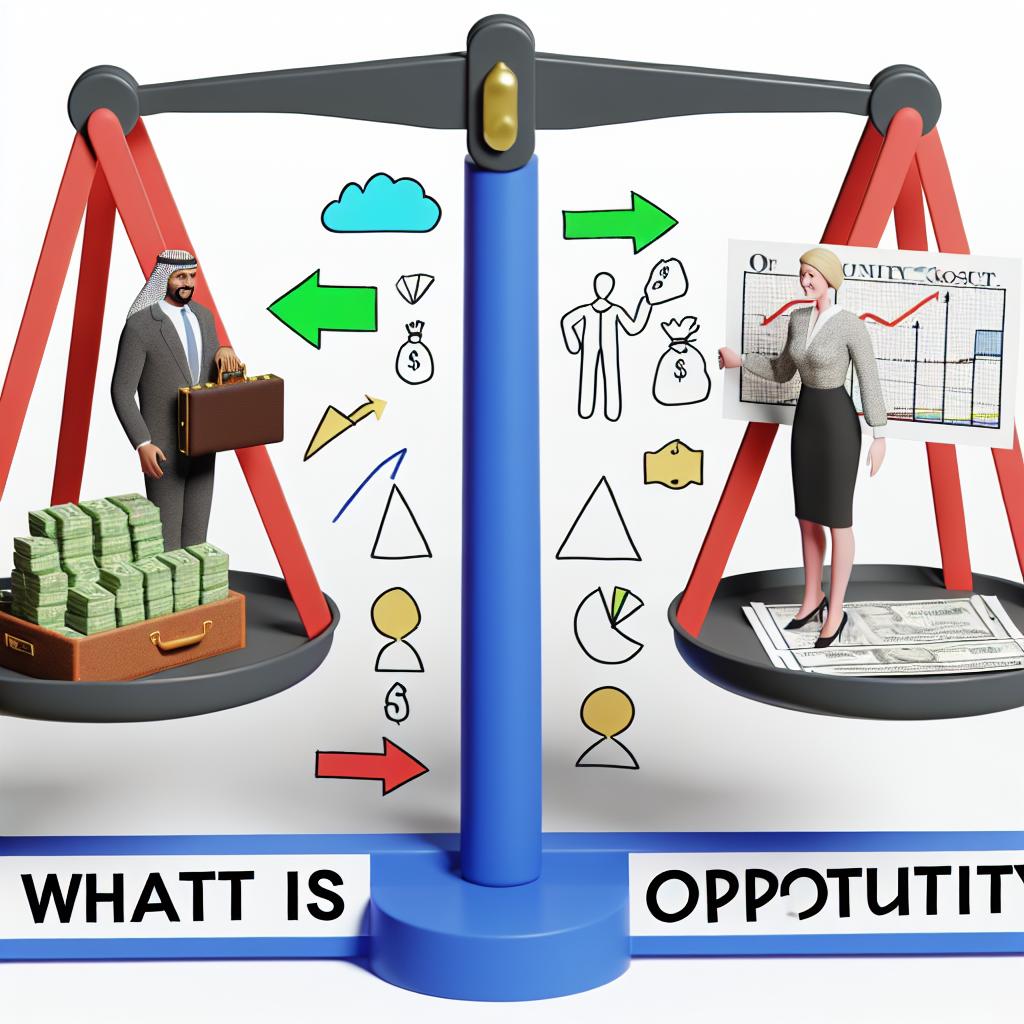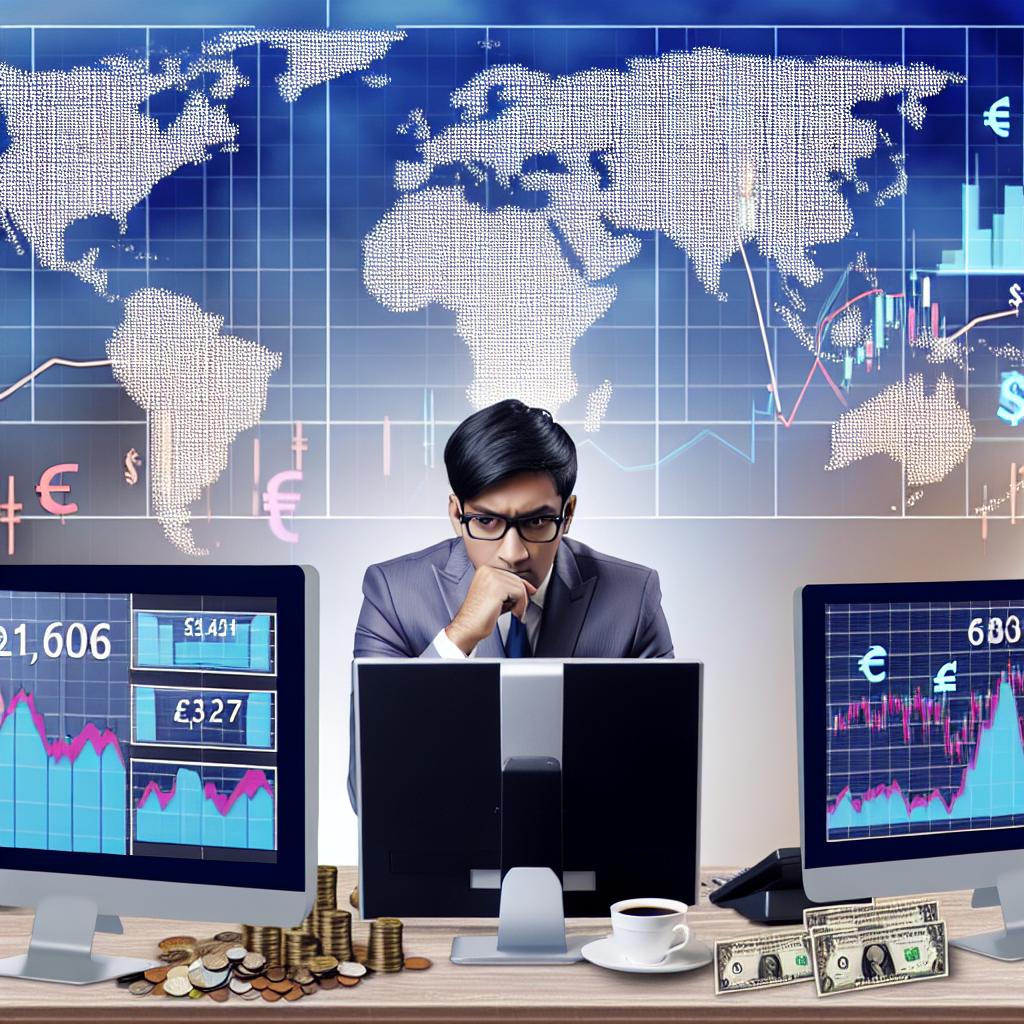Archives: What is Opportunity Cost in Economics?

Understanding Opportunity Cost in Economics
In the realm of economics, the concept of opportunity cost is a pivotal element in decision-making processes. It represents the benefits or value one misses out on when choosing one alternative over another. Understanding opportunity cost is essential for economic agents, including individuals, businesses, and governments, as it aids in making informed choices.
Defining Opportunity Cost
Opportunity cost can be defined as the value of the next best alternative foregone when a decision is made. It is not just about financial costs; instead, it encompasses any kind of profit, benefits, or value that one forgoes. Unlike explicit costs, which involve direct monetary transactions, opportunity cost involves the evaluation of all available alternatives to assess the trade-offs.
The Importance in Resource Allocation
In economics, resources are often limited, and thus, the decision on how to allocate them effectively depends heavily on understanding opportunity cost. For instance, if a company decides to spend resources on developing a new product rather than improving an existing one, the opportunity cost is the potential profit it might have earned from enhancing the current product line. This concept extends beyond financial returns, covering factors like time, labor, and expertise, which are crucial for optimizing resource allocation.
Applications in Personal Decisions
On an individual level, opportunity cost plays a crucial role in various personal decisions. For example, choosing to spend money on a vacation means those funds cannot be invested or spent on other goods and services. Similarly, pursuing further education may involve the opportunity cost of lost income during that time period. More broadly, when individuals decide how to spend their time, such as choosing between leisure activities and part-time work, they are inherently considering the opportunity cost of their choices.
Examples in Business Context
Businesses frequently face scenarios where understanding opportunity cost can significantly impact their strategic decisions:
Investment Decisions: When a company decides to invest in one project over another, the foregone profits from the rejected project(s) become the opportunity cost. This requires evaluating potential returns and associated risks. For instance, a firm might choose to expand its manufacturing capacity instead of investing in new technology. The future benefits of the technological investment represent the opportunity cost of this decision.
Production Choices: Firms often need to decide which products to produce with their limited resources. The opportunity cost is the value of the products that are not produced. For example, if a factory allocates its resources to manufacture laptops instead of smartphones, the profits from unproduced smartphones constitute the opportunity cost.
The Role in Government Policy
Governments also must consider opportunity costs when allocating budgets across various sectors such as healthcare, education, and defense. A decision to allocate more funds to infrastructure might result in an opportunity cost of not enhancing healthcare services. In policy-making, understanding these trade-offs assists in crafting policies that balance societal needs with available resources.
Socio-Economic Implications
Opportunity cost doesn’t only affect direct economic decisions; it has broader implications on socio-economic planning. By recognizing opportunity costs, policymakers can prioritize sectors that promise the greatest aggregate benefit to society. For example, investing in education might lead to long-term economic growth, but the opportunity cost might be immediate infrastructure developments.
Limitations of Opportunity Cost
While opportunity cost is a valuable concept, it does have limitations due to subjective valuation and the challenge of measuring intangible and future benefits accurately. Estimations can be complex, leading to potential inaccuracies in decision-making frameworks. Moreover, opportunity costs are often only apparent with hindsight, complicating accurate predictions at the moment a decision is made.
Conclusion
Understanding opportunity cost is crucial for making rational and informed economic decisions. Whether it’s about personal budgeting or corporate investment, acknowledging what is sacrificed in favor of a chosen path enables better strategic planning. To further grasp opportunity cost concepts, explore more resources from trusted economic sites like Investopedia or The Economic Times.
By integrating opportunity cost analysis into decision-making processes, individuals and organizations can enhance their capacity to make choices that optimize their available resources and maximize potential benefits. Opportunity cost urges decision-makers to think critically about scarcity and prioritization, ultimately fostering a more efficient allocation of resources at every level, from personal finance to global economic policy.
To deepen your understanding of opportunity cost and its profound implications on decision-making, continuing education in economic theory and principles is valuable. Many universities and online platforms offer comprehensive courses on this subject, laying a solid groundwork for mastering economic strategy. By equipping themselves with this knowledge, individuals can navigate complex economic landscapes with greater confidence and insight, ensuring that their decisions align with long-term objectives.
Indeed, taking time to reflect on the less visible costs of our choices encourages a more nuanced perspective on economic decisions. This recognition goes beyond simple cost-benefit analyses, urging a broader view that considers not just immediate gains but also long-term impacts and opportunities missed. Through consistent practice and incorporation into strategic planning, the concept of opportunity cost can transform into an invaluable tool in both personal and professional arenas. It provokes deeper, more informed thinking, ultimately leading to outcomes that better serve the growth and sustainability aspirations of all economic participants.
Archives: The Importance of Productivity in Economic Growth

The Role of Productivity in Economic Growth
Productivity is a critical factor in understanding economic growth. The connection between productivity and economic growth is well-established within economic theory, as increased productivity is often synonymous with a more robust and resilient economy. In its simplest form, productivity measures how efficiently production inputs, such as labor and capital, are utilized to produce a given level of output. An exploration of this concept provides profound insights into how economies can grow and develop over time.
Understanding Productivity
Productivity can be defined as the ratio of output to input. It serves as an essential indicator of efficiency, reflecting how well resources are utilized within an economy. This metric is crucial for businesses, policymakers, and economists because it provides insight into the functioning and potential growth of an economy. When productivity increases, it often indicates that more goods and services are being produced from the same amount of resources, subsequently leading to economic growth.
Productivity is not just about producing more goods with the same resources; it is also about improving quality. When businesses become more productive, they can invest resources in enhancing the quality of their products and services. This dual focus on quantity and quality can drive consumer satisfaction and further fuel economic growth.
Why Productivity Matters for Economic Growth
Increases in productivity are crucial for sustaining long-term economic growth. Rising productivity allows economies to produce more goods and services without a proportional increase in the input of labor and capital. This results in several economic benefits:
Enhanced Living Standards: As productivity grows, so too do wages and the standard of living. Businesses can afford to pay more when they generate higher outputs with the same input costs. Increased wages result in higher consumer spending, contributing to further economic expansion.
Increased Competitiveness: Economies that demonstrate high productivity levels can more effectively compete in the global market. This competitive advantage can lead to a greater share of international markets and increased export revenues. By being able to produce at lower costs or higher qualities, businesses can expand their market reach and economic influence.
Innovation and Technological Advancements: High productivity often correlates with innovation. Businesses and economies that engage in research and development can improve their processes and technologies, thereby enhancing productivity further. The relationship between innovation and productivity is cyclical—innovation leads to productivity gains, which fund further research and development.
The Mechanisms of Productivity Growth
Several important mechanisms enhance productivity:
Technology and Innovation: Advances in technology, such as automation and digitalization, directly contribute to productivity gains by allowing for more efficient production processes. Companies that invest in cutting-edge technologies often find themselves at the forefront of their industries, benefiting from reduced costs and increased production speeds.
Human Capital Improvements: Education and training play crucial roles in increasing the skill levels of the workforce. A well-educated workforce is more capable of innovating and adapting to new technologies, improving the overall ability to contribute effectively to the production process. Investment in human capital is, therefore, a key component of national and business strategies for boosting productivity.
Efficient Resource Allocation: Proper allocation of resources ensures that capital, labor, and materials are used where they are most effective, minimizing waste and maximizing output. Economies that prioritize efficient resource use can achieve significant productivity improvements, contributing to sustainable growth.
Challenges and Considerations
While productivity growth is a fundamental component of economic development, it is not without its challenges. One significant issue is that technological advances can lead to disruptions in the labor market, necessitating policy interventions to address potential unemployment or underemployment. As automation and artificial intelligence replace certain jobs, economies must transition workers into new roles and industries.
Another challenge lies in the measurement of productivity, especially in service-oriented economies where outputs are not always tangible. Measuring productivity in sectors like healthcare, education, or creative industries can be complex, as quality improvements and consumer satisfaction must be considered alongside raw output figures.
Moreover, environmental sustainability poses a challenge. Increasing productivity must be balanced with ecological considerations to ensure long-term economic health without depleting natural resources. Policymakers must craft strategies that encourage green technologies and sustainable practices.
Conclusion
Understanding the importance of productivity in economic growth reveals that strategies to improve productivity are crucial for policymakers and businesses alike. Investing in technological innovation, education, and efficient resource management can potentiate a cycle of sustained economic prosperity. Strategies might include policies to support lifelong learning, incentives for research and development, and frameworks that encourage smart and sustainable resource use.
Therefore, productivity remains a pivotal focus for driving economic advancement and improving living standards worldwide. Addressing the challenges associated with productivity growth requires coordinated efforts across various sectors and disciplines, ensuring that economies can enjoy the benefits of higher productivity without the associated drawbacks. By doing so, nations can achieve robust economic growth that is inclusive, sustainable, and resilient in face of global challenges. For more insights on economic growth strategies, visit this resource.
Archives: What is a Trade Surplus vs. a Trade Deficit?

Understanding Trade Surplus and Trade Deficit
A country’s economic health is often gauged by its balance of trade, which measures the difference between the value of its exports and imports. Two critical concepts in this context are trade surplus and trade deficit.
What is a Trade Surplus?
A trade surplus occurs when the value of a country’s exports exceeds the value of its imports over a given period. This surplus indicates that the country is selling more goods and services to foreign countries than it is purchasing from them. A trade surplus can be seen as a sign of economic strength, as it suggests that the global demand for the country’s goods or services is strong.
Benefits of a Trade Surplus
By maintaining a trade surplus, a country might increase its foreign currency reserves, enhance the global competitiveness of its industries, and potentially strengthen its currency. Countries often aim for a trade surplus to encourage industrial growth and job creation.
Increase in Foreign Currency Reserves
One substantial advantage of having a trade surplus is the potential increase in foreign currency reserves. When a nation exports more than it imports, it typically receives foreign currencies in exchange for its goods and services. These currencies can then be used to stabilize the country’s own currency, manage inflation, and finance imports of essential goods that are not produced domestically. The accumulation of foreign reserves provides a financial cushion that can be advantageous in times of economic uncertainty.
Enhancement of Industry Competitiveness
Another significant benefit of a trade surplus is the enhanced competitiveness of national industries on the global stage. When a country’s products are in demand internationally, it often drives innovation and efficiency as businesses strive to maintain or increase market share. This push for better quality products or more efficient production processes can lead to a more robust national economy and greater industrial growth over time.
Potential Strengthening of Currency
A sustained trade surplus may lead to an appreciation of the national currency. As demand for the country’s exports increases, foreign buyers need the local currency to pay for these goods, thereby increasing its value. A stronger currency makes imports cheaper, benefiting consumers and businesses that rely on imported goods. However, it can also pose challenges for exporters, as their goods may become relatively more expensive for foreign buyers.
What is a Trade Deficit?
In contrast, a trade deficit happens when the value of a country’s imports exceeds the value of its exports. This means that the country is buying more from other countries than it is selling to them. While sometimes perceived negatively, a trade deficit can also suggest a robust consumer demand within a country.
Implications of a Trade Deficit
Trade deficits can have multiple implications. On the one hand, they may indicate a growing economy with strong consumer purchasing power. On the other hand, persistent trade deficits might signal competitive weaknesses and could lead to increased foreign debt if funded through borrowing.
Indicator of Strong Consumer Demand
One interpretation of a trade deficit is that it reflects buoyant consumer demand, as citizens or businesses buy more goods than the country produces. This dynamic can be beneficial, particularly in economies where domestic production is not sufficient to satisfy consumer demand. It suggests that the country’s residents have the financial means to purchase goods from abroad, supporting a high standard of living and diverse market offerings.
Potential Drawbacks of a Persistent Trade Deficit
Despite the potential positives, persistent trade deficits can signal underlying economic issues. Over time, relying heavily on imports can indicate that domestic industries are not competitive or innovative enough to meet market demands. This dependence on foreign goods and services might create vulnerabilities, especially if it leads to significant borrowing from other countries. The accrued debt can burden future generations, impacting socioeconomic planning and development efforts.
Trade Balance and Economic Policies
The balance of trade, whether a surplus or deficit, often influences a country’s economic policies. Policymakers may implement measures to adjust the balance, such as tariffs to protect domestic industries, or subsidies to boost exports. However, such measures can lead to international trade tensions.
Tariffs and Trade Protection
One method countries use to address trade imbalances is the application of tariffs on imported goods. Tariffs increase the cost of foreign products, making them less competitive compared to local production. This approach seeks to protect domestic industries from international competition, fostering growth and job creation within the country’s borders.
Subsidies and Export Promotion
Another strategy involves subsidies aimed at promoting exports. By offering financial advantages to key industries, governments strive to make their domestic goods and services more appealing in international markets. Increased exports can help narrow a trade deficit or contribute to expanding a trade surplus by enhancing the competitive edge of national enterprises.
Impacts on International Trade Relations
While such policies can adjust trade balances, they may also generate friction between countries. Tariffs, for instance, can lead to retaliatory measures, sparking trade disputes. Similarly, subsidies might be perceived as unfair competition, leading to grievances in international forums. These complexities underscore the delicate nature of trade negotiations and the importance of cooperation in achieving mutually beneficial outcomes.
Conclusion
Both trade surpluses and trade deficits have distinct impacts on a nation’s economy. While a surplus can signify strong international demand, a deficit may reflect dynamic domestic consumption. Understanding these concepts helps in analyzing a country’s economic strategy and its implications for global trade dynamics. In essence, a nuanced view of trade balances can provide deeper insights into the economic landscape, enabling policymakers and businesses to make informed decisions in an interconnected world. Such insight is crucial in crafting strategies that safeguard national interests while fostering international collaboration and stability.
Archives: Understanding Exchange Rates and Currency Valuation

Introduction to Exchange Rates
Exchange rates serve as a pivotal element in the realm of economics and finance, influencing how currencies are exchanged on the global stage. At their core, exchange rates dictate the value of one currency in terms of another, playing an integral role in international trade, investment, and travel. A comprehensive understanding of exchange rates necessitates an exploration of the reasons behind their fluctuations and their broader impact on global economies.
What Influences Exchange Rates?
The dynamics of exchange rates are multifaceted and are swayed by various economic indicators and external factors. Among the most significant influences are interest rates, inflation, and a country’s economic stability.
Interest rates are crucial as they directly affect how attractive a currency is to investors. Countries boasting higher interest rates tend to draw increased foreign capital, as investors seek better returns on their investments, leading to an appreciation of that country’s currency. Conversely, nations with lower interest rates may see their currency value decline as investors look elsewhere for better returns.
Inflation also plays a critical role. When a country experiences high inflation, its currency typically depreciates because inflation diminishes purchasing power. People and businesses would need more of that currency to buy the same goods and services, causing the currency to lose value on the international stage.
Economic Stability and Confidence
Economic stability and investor confidence are significant factors in determining the valuation of a country’s currency. A nation enjoying political stability and robust economic performance is likely to inspire confidence among investors, potentially leading to currency strength. On the other hand, political turmoil or economic challenges can deter investment, causing a currency to weaken. Thus, confidence and perception can materially affect currency value beyond mere statistical measurements.
Supply and Demand Dynamics
The law of supply and demand is a fundamental principle when it comes to foreign exchange markets. The value of a currency is largely dictated by its demand relative to its supply. An increase in demand for a particular currency, driven by factors such as attractive interest rates or a booming export sector, often results in an appreciation of that currency.
Role of Central Banks
Central banks wield considerable influence over exchange rates using monetary policy and direct interventions in foreign exchange markets. They may opt to buy or sell their own currency to achieve desired economic objectives, such as controlling inflation or boosting exports. Such interventions can have immediate effects and are often part of broader policy strategies aimed at maintaining or adjusting economic equilibrium.
The Impact of Speculation
The foreign exchange market is highly susceptible to speculation, where traders and investors act based on their expectations of future currency movements. This speculative activity can introduce considerable volatility into the market as participants react to anticipated economic changes, such as shifts in monetary policy.
Long-term Valuation
While speculation can drive short-term fluctuations, long-term currency valuation relies more heavily on fundamental economic factors. GDP growth, productivity improvements, and the balance of trade are key indicators that analysts consider when evaluating a currency’s longer-term prospects. Over time, these stable indicators tend to provide a more reliable foundation for assessing currency strength.
Effects on International Trade
Exchange rates significantly influence international trade dynamics. A strong national currency can render a country’s exports more expensive for foreign buyers, potentially leading to a trade deficit as exports dwindle. Conversely, a weaker currency can render exports cheaper and imports more costly, potentially fostering a trade surplus. Consequently, nations must carefully manage their exchange rates to maintain favorable trade conditions.
Impact on Consumers and Businesses
The ripples of exchange rate fluctuations extend to consumers and businesses engaged in international commerce. For consumers, exchange rates directly impact the cost of imported goods and travel expenses. A stronger domestic currency generally means cheaper overseas travel and imported products.
Businesses, particularly those trading internationally, face the challenge of managing exchange rate risk, which refers to the potential for financial loss due to unfavorable currency movements. To mitigate this risk, companies often employ hedging strategies, such as using financial contracts to lock in exchange rates, safeguarding against unexpected shifts.
Tools for Understanding Exchange Rates
For those interested in understanding exchange rates more deeply, an array of online resources and analytical tools are available. Financial websites provide users access to real-time exchange rate data, allowing them to monitor changes as they happen. Furthermore, these platforms often offer economic analyses and forecasts, providing insight into potential future movements.
To gain more thorough expertise, individuals may explore publications from renowned financial institutions and international economic organizations. These resources delve into the intricacies of currency valuation and foreign exchange markets with significant depth.
Conclusion
A solid grasp of exchange rates and currency valuation is indispensable for anyone participating in global markets—be they a consumer, investor, or business owner. This complex subject encompasses a variety of factors, ranging from macroeconomic indicators to market psychology and government interventions. By understanding these dynamics, individuals and businesses can better navigate the complexities of the international financial landscape, making more informed decisions and adapting to an ever-changing economic environment.
Archives: What is Hyperinflation and When Does It Happen?

Understanding Hyperinflation
Hyperinflation represents an extreme and often alarming phase of inflation characterized by an unusually rapid escalation of prices in an economy over a brief period. When such an inflationary surge occurs, the inflation rate exponentially surpasses typical levels, escalating beyond 50% per month or reaching over 1,000% annually. This swift and rampant inflation severely erodes the purchasing power of the currency, leading to widespread economic implications.
Causes of Hyperinflation
Hyperinflation is generally triggered by a variety of interrelated factors, predominantly involving the excessive expansion of the money supply without underlying economic growth. When a government opts to print more currency to bridge its fiscal deficits or fund expenditures without a proportionate rise in goods and services, the currency’s value diminishes. Here, we delve deeper into the principal causes:
Loss of Confidence in the Currency: One of the critical precursors to hyperinflation is the erosion of trust among the populace in the stability and value of their currency. When faith in the currency wanes, individuals and businesses become less inclined to retain it, instead seeking to convert their holdings into more stable assets or foreign currencies. This rush to ‘dump’ the currency further accelerates its devaluation.
Political Instability: Hyperinflation often coincides with periods of political turbulence. In such scenarios, governments might resort to excessive money printing as a quick fix to address immediate financial obligations or to fund populist measures aimed at quelling dissent. Unfortunately, while this might provide short-term relief, it typically exacerbates the inflationary situation, fuelling further currency depreciation.
Economic Shocks: Significant and sudden economic shocks, such as wars, revolutions, or natural disasters, can drastically curb an economy’s capacity to produce and supply goods. These disruptions lead to shortages that, when combined with an inflated money supply, can spiral into hyperinflation. The diminished production capacity means fewer goods chasing more money, inevitably inflating prices.
Historical Examples
Although hyperinflation is relatively rare, history offers poignant lessons through several striking examples that underscore the destructive power of unrestrained price surges:
Germany in the 1920s: The post-World War I era was a tumultuous time for Germany, grappling with the economic aftermath of the Treaty of Versailles. The onerous reparations payments, compounded by a need to stimulate growth within a battered economy, led the Weimar government to print more money. This decision inadvertently triggered hyperinflation, reaching dramatic levels where prices doubled almost daily at its height, causing immense social and economic challenges.
Zimbabwe in the Late 2000s: Zimbabwe’s hyperinflationary crisis became a textbook example of economic collapse. The catalyst was a series of contentious land reforms coupled with a significant decline in agricultural production. In a desperate attempt to sustain the economy, the government printed money recklessly, culminating in an astronomical inflation rate that reportedly peaked at 89.7 sextillion percent per month. The consequences were catastrophic, leading to severe poverty and the collapse of the country’s financial system.
Venezuela in the 2010s: The hyperinflation experienced by Venezuela in recent years stemmed largely from weak economic policies and a drastic drop in global oil prices, heavily affecting the country’s oil-dependent economy. Government mismanagement paired with persistent monetary expansion led to hyperinflation, drastically reducing purchasing power and causing widespread socioeconomic disruption. The decline in basic living standards was compounded by shortages of essential goods and services.
Consequences of Hyperinflation
The onset of hyperinflation signals profound disruption within an economy, with pervasive and multifaceted consequences. Its impacts are wide-ranging and typically involve:
Erosion of Savings: Hyperinflation rapidly dilutes the value of accumulated savings. Both individual savers and financial institutions find their reserves diminishing in real terms, eroding wealth and destabilizing banking systems.
Reduction in Purchasing Power: Hyperinflation creates a scenario whereby wages and salaries fail to keep pace with soaring prices. Consequently, people find their standard of living drastically reduced as basic goods and services become unaffordable, accentuating economic inequality and societal distress.
Market Instability: With prices changing rapidly and unpredictably, market conditions become volatile. Businesses struggle to plan and operate effectively, often leading to supply chain disruptions and shortages. This instability not only constrains economic growth but also breeds an environment where speculative behaviors can thrive.
Barter Economies: As hyperinflation devalues the local currency, trust and utility in money as a medium of exchange decline. People revert to bartering—trading goods and services directly—as a more reliable means of transaction. While barter might offer a temporary solution for some, it leads to inefficiencies and highlights the breakdown of the formal monetary system.
For those interested in exploring the intricate dynamics of hyperinflation and its broader implications on global economies, extensive resources and scholarly investigations are accessible. Academic publications and research institutions frequently offer comprehensive analyses and elucidations of historical instances of hyperinflation, providing deeper insights into its systemic repercussions and preventive strategies.
Conclusion
Hyperinflation, though not frequently encountered, remains a perilous economic phenomenon due to its potential to wreak havoc on economies and societies. Comprehending its underpinning causes and far-reaching consequences is crucial for economists, policymakers, and the public alike. By identifying emerging signs of monetary instability and implementing sound economic policies, it is possible to forestall hyperinflationary cycles and mitigate their impact, safeguarding regional and global economic stability.
Categories
- Uncategorized
 (31)
(31)

